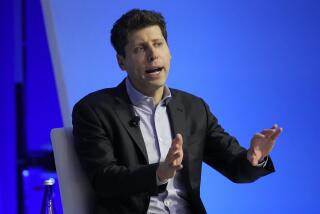Call centers replaced many doctors’ receptionists. Now, AI is coming for call centers

- Share via
- Artificial intelligence products with lifelike voices are being marketed to schedule or cancel medical visits, refill prescriptions, and help triage patients.
- Soon, many patients might initiate contact with the health system not by speaking with a human but with AI.
At one call center in the Philippines, workers help Americans with diabetes or neurological conditions troubleshoot devices that monitor their health. Sometimes they get pressing calls: elderly patients who are alone and experiencing a medical emergency.
“That’s not part of the job of our employees or our tech supports,” said Ruth Elio, an occupational nurse who supervised the center’s workers when she spoke with KFF Health News last year. “Still, they’re doing that because it is important.”
Elio also helped workers with their own health problems, most frequently headaches or back pains, borne of a life of sitting for hours on end.
In a different call center, Kevin Asuncion transcribed medical visits from half a world away, in the United States. You can get used to the hours, he said in an interview last year: 8 p.m. to 5 a.m. His breaks were mostly spent sleeping; not much is open then.
Health risks and night shifts aside, call center workers have a new concern: artificial intelligence.
Startups are marketing AI products with lifelike voices to schedule or cancel medical visits, refill prescriptions, and help triage patients. Soon, many patients might initiate contact with the health system not by speaking with a call center worker or receptionist, but with AI. Zocdoc, the appointment-booking company, has introduced an automated assistant it says can schedule visits without human intervention 70% of the time.
The medically focused call center workforce in the Philippines is a vast one: 200,000 at the end of 2024, estimates industry trade group leader Jack Madrid. That figure is more than the number of paramedics in the United States at the end of 2023, according to the Bureau of Labor Statistics. And some employers are opening outposts in other countries, like India, while using AI to reshape or replace their workforces.
Still, it’s unclear whether AI’s digital manipulations could match the proverbial human touch. For example, a recent study in Nature Medicine found that while some models can diagnose maladies when presented with a canned anecdote, as prospective doctors do in training, AI struggles to elicit information from simulated patients.
“The rapport, or the trust that we give, or the emotions that we have as humans cannot be replaced,” Elio said.
Sachin Jain, president and chief executive of Scan Health Plan, an insurer, said humans have context that AI doesn’t have — at least for now. A receptionist at a small practice may know the patients well enough to pick up on subtle cues and communicate to the doctor that a particular caller is “somebody that you should see, talk to, that day, that minute, or that week.”
The turn toward call centers, while creating more distance between a caller and a health provider, preserved the human touch. Yet some agents at call centers and their advocates say the ways they are monitored on the job undermine care. At one Kaiser Permanente location, it’s a “very micromanaging environment,” said one nurse who asked not to provide her name for fear of reprisal.
“From the beginning of the shift to your end, you’re expected to take call after call after call from an open queue,” she said. Even when giving advice for complex cases, “there’s an unwritten rule on how long a nurse should take per call: 12 minutes.”
Meanwhile, the job is getting tougher, she said. “We’re the backup to the healthcare system. We’re open 24/7,” she said. “They’re calling about their incision sites, which are bleeding. Their child has asthma, and the instructions for the medications are not clear.”
One nurses union is protesting a potential AI management tool in the call centers.
“AI tools don’t make medical decisions,” Kaiser Permanente spokesperson Vincent Staupe told KFF Health News. “Our physicians and care teams are always at the center of decision-making with our patients and in all our care settings, including call centers.”
Kaiser Permanente is not affiliated with KFF, a health information nonprofit that includes KFF Health News.
Some firms cite 30% to 50% turnover rates — stats that some say make a case for turning over the job to AI.
Call centers “can’t keep people, because it’s just a really, really challenging job,” said Adnan Iqbal, co-founder and CEO of Luma Health, which creates AI products to automate some call center work. No wonder, “if you’re getting yelled at every 90 seconds by a patient, insurance company, a staff member, what have you.”
To hear business leaders tell it, their customers are frustrated: Instead of the human touch, patients get nothing at all, stymied by long wait times and harried, disempowered workers.
One time, Marissa Moore — an investor at OMERS Ventures — got a taste of patients’ frustrations when trying to schedule a visit by phone at five doctors’ offices. “In every single one, I got a third party who had no intel on providers in the office, their availability, or anything.”
These types of gripes are increasingly common — and getting the attention of investors and businesses.
Customer complaints are hitting the bottom lines of businesses — like health insurers, which can be rewarded by the federal government’s Medicare Advantage policies for better customer service.
When Scan noticed a drop in patient ratings for some of the medical providers in its insurance network, it learned those providers had switched to using centralized call centers. Customer service suffered, and the lower ratings translated into lower payments from the federal government, Jain said.
“There’s a degree of dissatisfaction that’s bubbling up among our patients,” he said.
So, for some businesses, the notion of a computer receptionist seems a welcome solution to the problem of ineffectual call centers. AI voices, which can convincingly mimic human voices, are “beyond uncanny valley,” said Richie Cartwright, the founder of Fella, a weight loss startup that used one AI product to call pharmacies and ask if they had GLP-1s in stock.
Prices have dropped, too. Google AI’s per-use price has dropped by 97%, company CEO Sundar Pichai claimed in a 2024 speech.
Some boosters are excited to put the vision of AI assistants into action. Since the second Trump administration took office, policy initiatives by the advisory group known as the Department of Government Efficiency, led by Elon Musk, have reportedly explored using artificial intelligence bots for customer service at the Department of Education.
Most executives interviewed by KFF Health News — in the hospital, insurance, tech, and consultancy fields — were keen to emphasize that AI would complement humans, not replace them. Some resorted to jargon and claimed the technology might make call center nurses and employees more efficient and effective.
But some businesses are signaling that their AI models could replace human workers. Their websites hint at reducing reliance on staff. And they are developing pricing strategies based on reducing the need for labor, said Michael Yang, a venture capitalist at OMERS.
Yang described the prospect for businesses as a “we-share-in-the-upside kind of thing,” with startups pitching clients on paying them for the cost of 1½ hires and their AI doing the work of twice that number.
But providers are building narrow services at the moment. For example, the University of Arkansas for Medical Sciences started with a limited idea. The organization’s call center closes at 5 p.m. — meaning patients who try to cancel appointments after hours left a phone message, creating a backlog for workers to address the next morning that took time from other scheduling tasks and left canceled appointments unfilled.
So they started by using an AI system provided by Luma Health to allow after-hours cancellations and have since expanded it to allow patients to cancel appointments all day.
Michelle Winfeld-Hanrahan, the health system’s chief clinical access officer, who oversees its deployment, said UAMS has plenty of ideas for more automation, including allowing patients to check on prior authorizations and leading them through post-discharge follow-up.
Many executives claim AI tools can complement, rather than replace, humans. One company says its product can measure “vocal biomarkers” — subtle changes in tone or inflection — that correlate with disease and supply that information to human employees interacting with the patient.
Some firms are using large language models to summarize complex documents: pulling out obscure insurance policies, or needed information, for employees. Others are interested in AI guiding a human through a conversation.
Even if the technology isn’t replacing people, it is reshaping them. AI can be used to change humans’ behavior and presentation. Call center employees said in interviews that they knew of, or had heard omnipresent rumors of, or feared, a variety of AI tools.
At some Kaiser Permanente call centers, unionized employees protested — and successfully delayed — the implementation of an AI tool meant to measure “active listening,” a union flyer claimed.
And employees and executives associated with the call center workforce in the Philippines said they’d heard of other software tools, such as technology that changed Filipino accents to American ones. There’s “not a super huge need for that, given our relatively neutral accents, but we’ve seen that,” said Madrid, the trade group leader.
“Just because something can be automated doesn’t mean it should be,” he said.
Tahir writes for KFF Health News, a national newsroom that produces in-depth journalism about health issues and is one of the core operating programs at KFF — the independent source for health policy research, polling, and journalism.
More to Read
Inside the business of entertainment
The Wide Shot brings you news, analysis and insights on everything from streaming wars to production — and what it all means for the future.
You may occasionally receive promotional content from the Los Angeles Times.










